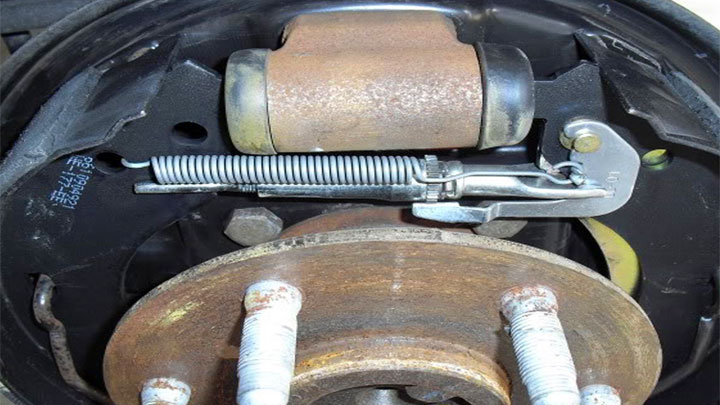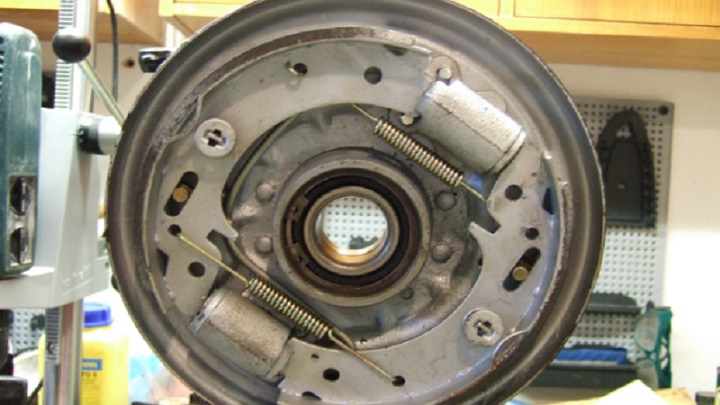How Do Drum Brakes Work? (and Their Pros/Cons)
Whether you drive a classic muscle car or an old pickup, chances are it’s equipped with drum brakes. These time-tested stoppers have been slowing vehicles for over a century using simple mechanics and readily available parts.
But how do drums convert kinetic energy into heat and bring your ride to a halt? We’ll look at the inner workings of this vintage technology that is surprisingly more efficient than disc brakes when it comes to stopping a vehicle.

See Also: Brake Shoes vs Brake Pads
Drum Brake System Components
Brake Drum and Wheel Cylinder
When it comes to drum brakes, the brake drum and wheel cylinder play very important roles.
The brake drum is bolted to the wheel hub and spins with the wheel. The wheel cylinder is responsible for converting hydraulic pressure into mechanical force, which pushes the brake shoes against the drum, slowing or stopping your car.
Brake Shoes and Springs
Your drum brake system relies on brake shoes to create friction. There are two types: primary and secondary shoes. The difference between brake pads and brake shoes is that pads are used in disc brake systems.
Springs keep the shoes in place and return them to their original position after braking.
Back Plate and Adjuster
The backing plate provides a rigid base for the components, supporting the housing and protecting it from debris. It also absorbs the torque from braking, earning its alternate name, the “Torque Plate.”
Coupled with the back plate, the adjuster maintains the right distance between the brake shoes and drum—a critical function in efficient braking.
How Drum Brakes Work

Let’s dive right into how drum brakes work in your car. So, you step on the brake pedal, and by doing so, you create pressure in the hydraulic brake fluid. This pressurized brake fluid moves through the brake lines, applying the braking force needed to slow down or stop your vehicle.
As the hydraulic pressure increases, it acts on a piston, which is present in the wheel cylinder. This piston then pushes against the brake shoes, which are located inside a rotating drum. The friction between the brake shoes and the drum is what brings your car to a halt.
Older vehicles (mostly before the 1970s) typically have drum brakes on all four wheels. After that, drum brakes would still be found on the rear wheels, while disc brakes are more common on the front wheels. Almost all modern vehicles now use disc brakes on all four corners but a few still incorporate drum brakes in the rear.
Heat and Friction
When you press your brake pedal, you might not realize just how much heat and friction are at play in bringing your vehicle to a halt. Drum brakes in particular rely on these forces to help your car come to a smooth stop.
Friction is created when the brake shoe presses against the rotating drum brake. The brake shoe is made of specialized materials designed to generate the perfect amount of friction to slow down the vehicle efficiently without damaging the components. As the drum rotates and comes into contact with the brake shoe, friction builds up, slowing down the wheel.
Heat is another key factor in the performance of drum brakes. As friction occurs between the drum and the brake shoe, a large amount of heat is generated. The brake drums themselves are usually made of cast iron, which is a material highly resistant to heat and wear. This all but guarantees that the drum can maintain its structural integrity even as temperatures rise during braking.
It’s worth noting that the friction material used in drum brakes has a strong effect on the overall performance of the braking system. Like with brake pads, different materials can either help dissipate heat more effectively or contribute to shorter stopping distances.
Drum Brake Maintenance and Repair
Regular Checks and Cleaning
To make sure your drum brake system is always in good working condition, you’ll want to perform regular checks and cleanings. Start by inspecting the brake shoes for wear and tear. Look for any signs of damage or uneven wear, which can cause decreased braking efficiency.
It’s also important to clean the brake drums and other components regularly. This can be done by removing the wheel and drum, and using brake cleaner to remove built-up dust, debris, and grime. To keep everything working smoothly, lubricate various moving parts, like the adjuster or the areas where the shoes contact the backing plates.
Replacement
Over time, wear and tear on brake shoes, springs, and other components can cause your drum brake system to become less efficient. If you start experiencing any of the following symptoms, it might be time for a replacement:
- The brake pedal feels spongy or soft
- Your car pulls to one side when braking
- You hear grinding or squeaking noises while braking
See Also: 3 Causes of a Stuck Parking Brake
Advantages and Disadvantages of Drum Brakes
Pros
- Longer lifespan due to increased friction contact area
- More stopping power than an equal diameter disc brake
- Lower production cost
- Simpler and more affordable maintenance due to all-in-one, enclosed design
- Require less frequent maintenance due to better corrosion resistance
Cons
- Tricky to operate compared to disc brakes
- Requires specialized brake tool to pry springs loose for part replacement
- Generates lower heat, which can be problematic in colder climates
- Typically found on rear wheels, compromising overall braking performance of vehicle when compared to disc brakes on front wheels
- Replace the Engine or Replace the Car? (11 Factors to Consider) - Apr 11, 2024
- Plastic Piece Dragging Under Your Car? (What It Is and What To Do) - Mar 21, 2024
- Timing Belt vs Timing Chain (What’s the Difference?) - Feb 27, 2024
